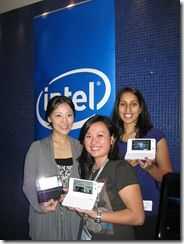Products
Only four new ultra-mobile products were introduced at IDF.
- ViliV S10. A 10 inch convertible netbook running on the Intel Atom 1.3Ghz Menlow Platform. [My overview video here]
- Archos 9. An 8.9 inch slate ultra mobile PC running Windows 7. $499 entry price. [My overview video here.]
- Digicube Z8. This slider MID is currently shipping in Asia. As yet I haven’t been able to find a huge amount of detail on it. My short hands on didn’t leave me with a great impressions though. The general build quality seemed very poor. [Image set here]
- UMID M2. The M2 builds on the M1 and corrects some issues that we highlighted. The unit now comes with real USB and headset ports, opens to a wider screen angle and will have options for 1GB RAM and Windows 7. Pricing starts at $499 within the next 3 months. My UMID M2 hands-on video is here.
Pinetrail.
Very little information was given about PineTrail, the next generation platform for Netbooks, at IDF. I’m speculating that it’s going to be using a GMA500 core and will be in-line with other Atom-based platforms. The big question is, will they include the ‘power gating’ feature which would allow a netbook to gain huge idle-state power advantages when running a Moblin OS.
Summary
Intel is clearly in the smartphone or ‘media phone’ game now. All the required components of hardware, software and developer ecosystem are in place and we’ll see the first devices shipping in the second half of 2010. With Moblin as the chosen operating system for the first phone-capable platform, Moorestown, it’s easy to see the potential reach of applications that are transported by Moblin. Intel speaks of an addressable market of ‘north of 400 million units’ by 2013 and that’s just in the mediaphone space. Add the 100 million+ netbooks that will ship between now and 2013 and with only a 10% penetration, you’ll be looking at 50 million Moblin devices. Clearly that’s something that anyone in the mobile internet market would be silly to ignore.
Intel Developer Forum content catalogue.
View the keynotes and other video content.
Intel Application Developer Program Website
MIDMoves.com Where I reported all the IDF news.
The IDF coverage through MIDMoves.com was sponsored by the Intel Insiders program.
Pages: 1 2












M&M&M's. What #IDF09 meant for mobility. (IDF summary of mobility related information) http://cli.gs/8AquN
M&M&Ms What IDF09 meant for Mobility. http://bit.ly/2vW2G
My old Zaurus C1000 consume less than 1 watt, including processors but also screen, flash memory, etc.
So for 1-watt PC, I think that ARM processors are definitively more interesting than Intel ones !
The matter is where you are going not where you come from. ARM processors are going to take longer to get to Intel power levels than intel to get ARM comsumption levels.
Is that really true, though? We’ll probably see quad-core Cortex A9 chips by the end of next year. The Cortex A family already have roughly equivalent instructions-per-second-per-clock to the Atom family.
Being limited to the ARM/Linux software library instead of the X86/Windows one is the real issue, I think.
As much I like ARM, they don’t run Windows.
They have a future in MIDs platform only if Linux distributions like Moblin becomes popular.
If this do not happen, they could consume 0.0001 watt , but still they would not sell units.
Good post, I look forward to the reduced power consumption that would be great if the moorestown platform was using half the power, but I don’t see that happening unless you only use the device infrequently and it’s on standby most of the time because of your individual usage behaviors.